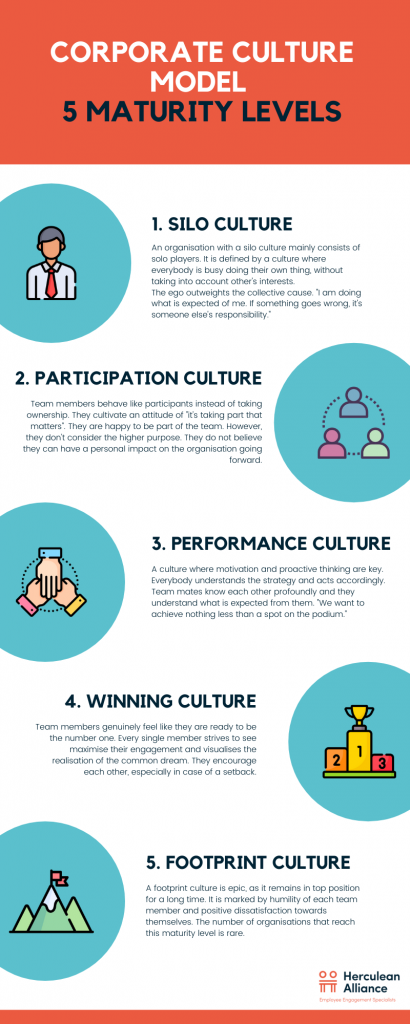In our consulting approach we measure corporate culture using the Cultural Maturity Model (CMM). In doing so, we help organisations capture the current level of maturity on a scale of 1 to 5. To move from one level to the next, we establish an action plan based on the specific context of this organisation.
Culture Maturity Model: an overview

The 5 maturity levels are as follows:
- Silo culture
- Participation Culture
- Performance Culture
- Winning culture
- Footprint Culture
1. Silo culture
An organisation with a silo culture is characterised by solo players. Everyone does their own thing, without checking what others are doing. The ego takes precedence over the collective interest. “I perform my job the way it should be done. If something goes wrong, it’s because of the others.” Self-interest prevails over group interest.
2. Participation culture
In a participation culture, a group feeling prevails and team members work together in a pleasant way. Colleagues feel like participants rather than leaders. Above all, employees radiate the attitude of “participating is more important than winning.” In other words, they like to be there, but do not believe in the higher purpose. They cannot imagine themselves having an impact on the social engineering of the future.
3. Performance culture
In a team with a performance culture, team members are open to feedback and consider it “food for champions.” Here we are talking about a culture where motivation and proactive work are central and the business strategy is clear to everyone. Teammates know each other’s strengths and weaknesses very well. They are very aware of what is expected of them. They go for a podium finish.
4. Winning culture
In the winner’s culture, the organisation comes first, even before team interest. There is a feeling among teammates that they are ready for the top. Each team member therefore makes every effort to see his commitment cashed in and can also visualize this. When setbacks occur, team members pat each other on the back instead of pointing fingers at each other.
5. Footprint culture
These organisations or teams are champions, and the organisational culture is one that takes on epic proportions. Team members cultivate an attitude of humility and positive dissatisfaction. As a result, they are able to stay at the top for longer periods of time. The footprint culture is given to few and is therefore very rare in business.
More info
The Culture Maturity Model was originally based on the model used by Alain Goudsmet of Mentally Fit Institute. As a former coach of Belgian Olympic teams and athletes (field hockey, tennis and athletics), the link to sports is never far from his mind.
Goudsmet’s current model contains four levels instead of five. It was also further enriched and cast in a data model. This gives companies the opportunity to have their maturity model captured through the platform with objectively measurable criteria.
Using surveys and our platform we take a picture of the current culture, in order to establish the AS IS situation. And what’s most interesting, is to see the differences in responses from management and employees. The first ones often being more optimistic about the organisational culture than the second group.
Where’s your organisation in the Culture Maturity Model? I’m quite convinced that you probably have an idea. The question is whether your opinion is shared by your employees or if they have a different view of where you currently are. Interested to know more? Contact us for a chat.
